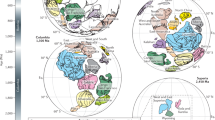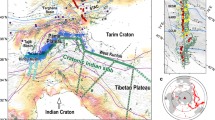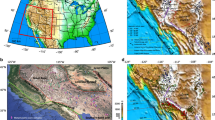Abstract
Supercontinents episodically assemble and break up, in association with the closure and opening of ocean basins1. During these cycles, continental margins are repeatedly weakened and deformed during subduction, orogeny and rifting, whereas continental cores tend to remain intact2,3. It has therefore been suggested that deformation during supercontinent cycles is controlled by the pre-existing structure of the lithosphere, for example by rheological heterogeneities and mechanical anisotropy that were acquired during past tectonic events4,5. However, observational constraints for this idea have been lacking. Here we present global, high-resolution maps of the lithosphere’s effective elastic thickness over the continents—a proxy for the rigidity or long-term strength of the lithosphere—calculated from a comparison of the spectral coherence between topography and gravity anomalies and the flexural response of an equivalent elastic plate to loading. We find that effective elastic thickness is high in Archean cratons, but low in the surrounding Phanerozoic belts. We also estimate the anisotropy in effective elastic thickness, indicative of a directional dependence of lithospheric rigidity, and show that directions of mechanical weakness align with large gradients in effective elastic thickness and with tectonic boundaries. Our findings support the notion that lithospheric rigidity is controlled by pre-existing structure, and that during the supercontinent cycle, strain is concentrated at pre-existing zones of weakness.
This is a preview of subscription content, access via your institution
Access options
Subscribe to this journal
Receive 12 print issues and online access
$259.00 per year
only $21.58 per issue
Buy this article
- Purchase on Springer Link
- Instant access to full article PDF
Prices may be subject to local taxes which are calculated during checkout



Similar content being viewed by others
References
Wilson, J. T. Did the Atlantic close and then re-open? Nature 211, 676–681 (1966).
Jordan, T. H. Composition and development of the continental tectosphere. Nature 274, 544–548 (1978).
Li, Z. X. et al. Assembly, configuration, and break-up history of Rodinia: A synthesis. Precambr. Res. 160, 179–210 (2008).
Thomas, W. A. Tectonic inheritance at a continental margin. GSA Today 16, 4–11 (2006).
Vauchez, A., Tommasi, A. & Barruol, G. Rheological heterogeneity, mechanical anisotropy and deformation of the continental lithosphere. Tectonophysics 296, 61–86 (1998).
Gurnis, M. Large-scale mantle convection and the aggregation and dispersal of supercontinents. Nature 332, 695–699 (1988).
Gurnis, M., Zhong, S. & Toth, J. in The History and Dynamics of Global Plate Motions (eds Richards, M. A., Gordon, R. G. & van der Hilst, R. D.) 73–94 (Am. Geophys. Union, 2000).
Lenardic, A., Moresi, L-N. & Mühlhaus, H. Longevity and stability of cratonic lithosphere: Insights from numerical simulations of coupled mantle convection and continental tectonics. J. Geophys. Res. 108, 2303 (2003).
Coltice, N. et al. Global warming of the mantle as the origin of flood basalts over supercontinents. Geology 35, 391–394 (2007).
Watts, A. B. Isostasy and Flexure of the Lithosphere (Cambridge Univ. Press, 2001).
Burov, E. B. & Diament, M. The effective elastic thickness (Te) of continental lithosphere: What does it really mean? J. Geophys. Res. 100, 3905–3927 (1995).
Kirby, J. F. & Swain, C. J. Mapping the mechanical anisotropy of the lithosphere using a 2D wavelet coherence, and its application to Australia. Phys. Earth Planet. Int. 158, 122–138 (2006).
Audet, P. & Mareschal, J-C. Wavelet analysis of the coherence between Bouguer gravity and topography: Application to the elastic thickness anisotropy in the Canadian Shield. Geophys. J. Int. 168, 287–298 (2007).
McKenzie, D. Estimating Te in the presence of internal loads. J. Geophys. Res. 108, 2438 (2003).
Kirby, J. F. & Swain, C. J. A reassessment of spectral Te estimation in continental interiors: The case of North America. J. Geophys. Res. 114, B08401 (2009).
Pérez-Gussinyé, M. & Watts, A. B. The long-term strength of Europe and its implications for plate forming processes. Nature 436, 381–384 (2005).
Audet, P., Jellinek, A. M. & Uno, H. Mechanical controls on the deformation of continents at convergent margins. Earth Planet. Sci. Lett. 264, 151–166 (2007).
Tassara, A., Swain, C., Hackney, R. & Kirby, J. Elastic thickness structure of South America estimated using wavelets and satellite-derived gravity data. Earth Planet. Sci. Lett. 253, 17–36 (2007).
Pérez-Gussinyé, et al. Effective elastic thickness of Africa and its relationship to other proxies for lithospheric structure and surface tectonics. Earth Planet. Sci. Lett. 287, 152–167 (2009).
Artemieva, I. M. Global 1×1 thermal model TC1 for the continental lithosphere: Implications for lithosphere secular evolution. Tectonophysics 416, 245–277 (2006).
Hyndman, R. D., Currie, C. A. & Mazzotti, S. Subduction zone backarcs, mobile belts, and orogenic heat. GSA Today 15, 4–10 (2005).
Ritsema, J., Jan van Heijst, H. & Woodhouse, J. H. Global transition zone tomography. J. Geophys. Res. 109, B02302 (2004).
Mégnin, C. & Romanowicz, B. The shear velocity structure of the mantle from the inversion of body, surface and higher modes waveforms. Geophys. J. Int. 143, 709–728 (2000).
Hyndman, R. D., Currie, C. A., Mazzotti, S. & Frederiksen, A. Temperature control of continental lithosphere elastic thickness, Te vs Vs. Earth Planet. Sci. Lett. 277, 539–548 (2009).
Lowry, A. R. & Smith, R. B. Strength and rheology of the western US Cordillera. J. Geophys. Res. 100, 17947–17963 (1995).
Simons, F. J. & van der Hilst, R. D. Seismic and mechanical anisotropy and the past and present deformation of the Australian lithosphere. Earth Planet. Sci. Lett. 211, 271–286 (2003).
Fouch, M. J. & Rondenay, S. Seismic anisotropy beneath stable continental interiors. Phys. Earth Planet. Int. 158, 292–320 (2006).
Yuan, H. & Romanowicz, B. Lithospheric layering in the North American craton. Nature 466, 1063–1068 (2010).
Heidbach, O. et al. The World Stress Map database release 2008, http://dc-app3-14.gfz-potsdam.de/index.html (2008).
Wüstefeld, A., Bokelmann, G., Barruol, G. & Montagner, J-P. Identifying global seismic anisotropy patterns by correlating shear-wave splitting and surface-wave data. Phys. Earth Planet. Int. 176, 198–212 (2009).
Acknowledgements
This work is supported by the Miller Institute for Basic Research in Science (UC Berkeley).
Author information
Authors and Affiliations
Contributions
P.A. performed data processing and inversion. P.A. and R.B. wrote the paper.
Corresponding author
Ethics declarations
Competing interests
The authors declare no competing financial interests.
Supplementary information
Supplementary Information
Supplementary Information (PDF 3422 kb)
Rights and permissions
About this article
Cite this article
Audet, P., Bürgmann, R. Dominant role of tectonic inheritance in supercontinent cycles. Nature Geosci 4, 184–187 (2011). https://doi.org/10.1038/ngeo1080
Received:
Accepted:
Published:
Issue Date:
DOI: https://doi.org/10.1038/ngeo1080
This article is cited by
-
Intracontinental lithospheric delamination: Constraints from imaging the mantle transition zone beneath the southwestern part of the Sichuan Basin
Science China Earth Sciences (2023)
-
Tectonic control on effective elastic thickness over the Northeast Indian Seamount Province and surrounding regions
Marine Geophysical Research (2021)
-
Victoria continental microplate dynamics controlled by the lithospheric strength distribution of the East African Rift
Nature Communications (2020)
-
The effects of the thermal state of overriding continental plate on subduction dynamics: Two-dimensional thermal-mechanical modeling
Science China Earth Sciences (2020)
-
Archean crust and metallogenic zones in the Amazonian Craton sensed by satellite gravity data
Scientific Reports (2019)



